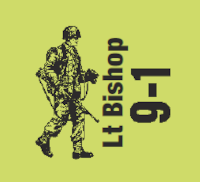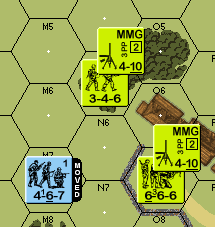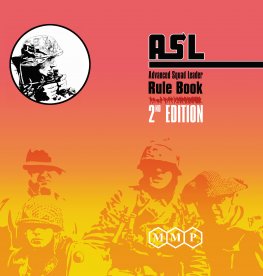
Twice in the past two weeks I was playing ASL when Subsequent First Fire (SFF) options for half squads came up. In both instances, my opponents pointed to a rule stating SFF can only attack Adjacent enemy units. Now for me, this is pretty frustrating. Not because they have read the rule wrong, but because it always takes me so long to remember where the rule is. This brief article will detail the issue and provide the answer’s correct location in the rule book. I hope that if this comes up again, I will remember where it is or at least be able to find this article to save me some time.
The Situation

Consider the example at left. The German squad moves into M7. The American squad could fire its inherent Firepower (FP), its MMG, or Fire Group (FG) both together. The HS can fire either its inherent FP or the MMG. It cannot fire both as a HS. Rule A7.352 makes this clear. This rule says “A crew/HS/SMC that fires any SW/Gun loses its inherent FP until attacked/attacking in CC or the end of that Player Turn”.
This rule has confused me. It seems to say a HS/crew may not use inherent FP again until CC. This isn’t correct either. So let’s keep digging.
Subsequent First Fire
The German unit is unharmed in First Fire and it continues to move to M6. What are the Subsequent First Fire (SFF) options for the two units? The rule covering SFF is A7.353. It is also worth noting that A7.353 is an EXC to A7.352. As such, SFF is an exception to a HS/crew giving up its inherent FP in First Fire. I am going to quote this rule entirely here so we can dissect it together. This rule is the source of confusion regarding the false limitation to adjacent targets.
A7.353 In both of the above cases, Subsequent First Fire (8.3), FPF (8.31), and Final Fire (8.4) vs adjacent units retain halved inherent FP for those attacks (regardless of how they were used during First Fire)—although use of full SW/Gun capability during such attacks can negate inherent FP in the normal manner. See the 8.41 EX.
What Does It Mean

This rule is telling us about three separate cases: SFF, FPF, and Final Fire vs adjacent targets. Only Final Fire is limited to use against adjacent units. This is just like ANY Infantry unit marked First Fire wishing to shoot in Final Fire. Halve a unit’s FP in SFF, FPF, or Final Fire and make a DR on the IFT. The final clause also says a HS/crew could opt to fire a SW/Gun but those attacks would negate inherent FP in the normal manner.
The correct interpretation of this rule allows a HS/crew to SFF against units in the normal manner when marked with a First Fire counter. When using SFF, it can fire its inherent FP or a SW/Gun it possesses normally. Any SW/Gun would be subject to Sustained Fire/Intensive Fire penalties. In Final Fire, a crew/HS could fire inherent FP or any SW/Gun it possesses against Adjacent targets. Again, SW/Guns would be subject to Sustained Fire/Intensive Fire penalties.
If marked Final Fired, these units could use FPF as well. Again, a crew/HS could opt to fire inherent FP or any SW/Gun it possesses. As stated earlier, any SW/Gun fired in this manner is subject to Sustained Fire/Intensive Fire penalties. If that crew/HS possesses a MG, it must forgo its inherent FP and instead use the MG as Sustained Fire (A8.31, A8.41 Example).
A squad firing in SFF may fire its inherent FP, a possessed SW, or both. If it elects to fire a SW/Gun in SFF Sustained Fire/Intensive Fire penalties would apply. Since it cannot Fire Group its inherent FP with a Gun’s FP, firing a Gun in SFF would negate its inherent FP.
The Difference
Some may see this and ask “then what’s the difference between a squad and HS?” I confess I originally struggled to answer this question. It took a quick call to McNamara (not by me, by a friend) to clear this up. Mac said this was a deliberate choice. There is a significant difference between the two unit types. A squad with a SW has two First Fire opportunities if it does not cower. It can also opt to SFF with inherent FP, a possessed SW, or both. Conversely, a HS only has one First Fire opportunity (inherent FP or SW) and one SFF opportunity (inherent FP or SW). In that light, the limitations of a half squad are quite stark.
Conclusion

I do not know how many people see A7.353 as limiting a HS to SFF against only Adjacent units. I think it interesting that the two players I faced making this claim are located half the world apart. This suggests this might be a widespread belief. I know I struggled with this early in my ASL experience but I have long since internalized this capability. This is so deeply ingrained in me I had forgotten how I built my understanding.
Now, I am spreading the gospel, besides creating a post so I can quickly locate the rules the next time this comes up. Maybe with this I won’t become so frustrated when trying to explain it. I hate not being able to find a rule when I know for sure that it exists. Sorry Paul and Gary. It wasn’t you. It was me.


I was one of the two players that Jim refers to in his analysis… you never stop learning when playing ASL.
Cheers Jim
Thanks for posting this article.
I’ve always hated this rule. It always seemed to me to allow a half squad to “have its cake and eat it too.” Now I’m even more of that mind now that I found out that the half squad can SFF against non-adjacent units.
Another excellent article, Jim. Thanks.
Dear Jim,
Could you clarify you sentence “If marked Final Fired, these units could use FPF as well. Again, a crew/HS could opt to fire inherent FP or any SW/Gun it possesses.”
I thought in FPF MG usage is mandatory, therefore a HS/crew must fire MG it posseses.(A8.31)
Thanks for your reply.
You are correct. The MG must fire as Sustained Fire. That is a mistake in the article which I will correct. I appreciate it.
Jim
Thanks for this. My interpretation of A7.353 is that a HS that 1st fired could only use its inherent in SFF. I have played it this way forever and never been challenged, I now see the error of my ways and will spread the gospel.